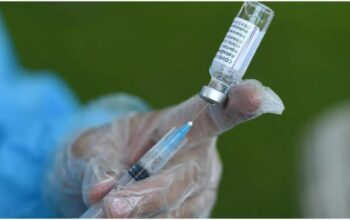A sickle cell test is a blood test that is used to determine if a person has a sickle cell trait or sickle cell disease (SCD). If a person has a family history of sickle cell disease, they are more likely to have the disease. If a person carries the sickle cell gene but doesn’t get sick, they have sickle cell trait. However, they may live a healthy and normal life but can pass the gene on to their children.
Sickle cell test
A sickle cell test is a simple blood test that checks for abnormal red blood cells known as sickle cells. This test is part of routine screening performed on a baby after they are born but older children and adults may need to be tested as well.
What is sickle cell disease (SCD)?
Sickle cell disease (SCD) or sickle cell anemia is a genetic disease of the red blood cells. The healthy red blood cells are round, move through small blood vessels to carry oxygen to all parts of the body. When a person has sickle cell disease, the red blood cells (RBC) are hard, sticky, and look C-shaped (like a farm tool called a sickle). These cells are destroyed by the body faster than normal body cells and cause a constant shortage of red blood cells. And can result in inadequate oxygen supply to the body. Besides, while traveling through small blood vessels, these cells get stuck & clog the blood flow which can cause pain and other serious problems like acute chest syndrome, stroke, and infection. People with SCD need special medical care throughout their lives to treat a variety of problems.
Causes
People with sickle cell anemia inherit the disease, in other words, the disease is passed on to them by their parents as part of their genetic makeup. Parents can’t give it to their children unless both have faulty hemoglobin in their red blood cells.
Types of sickle cell disease
- Hemoglobin SS disease
- Hemoglobin SC disease
- Hemoglobin SB+ (beta) thalassemia
- Hemoglobin SB 0 (Beta-zero) thalassemia
- Hemoglobin SD, hemoglobin SE, and hemoglobin SO (rare)
Symptoms
SCD can cause the following symptoms:
- Anemia
- Paleness & shortness of breath
- Frequent infections
- Delayed growth
- Vision problems
- Yellowing of the skin and eyes
- Periodic episodes of pain (which is caused by blocked blood flow)
- Swollen hands and feet
If you have any of the above symptoms, get tested for Sickle Cell Diseases.
Complications of sickle cell anemia
Types of complications that can result from sickle cell anemia may include.
- Splenic sequestration, a blockage of the splenic vessels by sickle cells
- Heart disease and chest syndromes
- Lung diseases
- Priapism
- Gallstones
- Sickle chest syndrome
- Neurological complications like seizures, strokes, or coma
- Blindness, caused by blockages in the vessels supplying the eyes
- Skin ulcers in the legs can occur
Who needs a sickle cell test?
Children with SCD can be more vulnerable to serious infections within weeks of birth. So, testing early helps infants with the disease get the proper treatment to protect their health.
Other people who should get tested include:
- Immigrants who haven’t been tested
- If family history is unknown
- Children who move from one state to another and haven’t tested before
- Any person with the symptoms of sickle cell disease (SCD)
What happens during a sickle cell test?
There is no specific preparation required for the sickle cell test. A blood sample is essential to test for SCD. During this test, an elastic band is placed around the upper arm to make the vein swell with blood. And a needle is inserted into the vein. After drawing blood, the lab technician will cover the area with a bandage to stop any bleeding.
For infants or very young children, the nurse uses a sharp tool to puncture the skin on the heel or finger. And they will collect the blood on a slide or test strip.
Risk of this test
This test is a normal blood test. People may feel a little lightheaded or dizzy after the test. However, these symptoms will go away after few minutes.
What do the results mean?
The lab tech will look for an abnormal form of hemoglobin called hemoglobin S in the blood sample. A negative test means the hemoglobin is normal. The positive test result may indicate that he/she has sickle cell trait or SCD. When the test is positive, the doctor may order a second test called hemoglobin electrophoresis, which helps them to determine which condition you have.
When the test shows that you have two abnormal hemoglobin genes, the doctor will likely make an SCD diagnosis. And when the test shows you have only one of these abnormal genes and no symptoms, the doctor will make the diagnosis of sickle cell trait.
If a person receives a sickle cell test within 90 days after a blood transfusion, it may lead to inaccurate test results. Because transfusion can reduce the amount of hemoglobin S (a protein that causes SCD in the blood). When a person has undergone a recent transfusion may have a normal sickle cell test result, even if they have SCD.
Treatment for sickle cell anemia
Usually, management of sickle cell anemia is aimed at avoiding pain episodes, relieving symptoms, and preventing complications. However, treatment may include medications and blood transfusions. For a few children and teenagers, a stem cell transplant may cure the disease. And bone marrow transplant is used to treat sickle cell anemia. There are different treatments are available for SCD:
- Blood transfusions can improve the transport of oxygen and nutrients.
- Rehydration with intravenous fluids can help red blood cells (RBC) return to a normal state. Because the red blood cells are more likely to deform & assume the sickle shape when a person is dehydrated.
- Pain medication can be used to relieve pain during a sickle crisis. One may need over-the-counter drugs or prescription pain medication like morphine.
- Droxia and Hydrea help to increase the production of fetal hemoglobin. And this may reduce the number of blood transfusions.
- Treating underlying or associated infections is an essential part of managing the crisis. Because the stress of infection may result in a sickle cell crisis.
- Supplemental oxygen through a mask makes breathing easier and also improves oxygen levels in the blood.
- As patients tend to have lower immunity, immunizations can help prevent infections.







